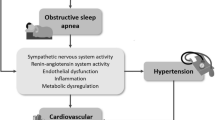Abstract
Craniofacial and anthropometric characteristics are identified risk factors for obstructive sleep apnea syndrome (OSAS). Phase 1 of this study used cephalometric radiographs to record craniofacial measurements from 60 OSAS subjects with a respiratory disturbances index (RDI) of 20 or greater (group A) and 60 subjects with a history of loud snoring and an RDI less than 20 (group B). From this data set, a craniofacial risk index (CRI) was constructed using age, body mass index (BMI), and 14 cephalometric measures previously reported to be associated with OSAS. A separating boundary (CRIS) was established by using discriminant analysis to differentiate between the two groups. All measurements were determined by an investigator who was blinded to the subjects’ RDI score. Phase 2 used a second sample of 19 group A and 47 group B subjects to test the ability of the CRI derived from the first sample to classify subjects in this second sample into the correct age group. The CRI was able to classify correctly 72.3% (34 of 47) of the group A subjects when all variables were used in the discriminant model. Using only four variables (age, BMI, hyoid mandibular plane distance, and tongue length) selected by the stepwise method, 72.3% (34 of 47) of the group B subjects and 78.7% of group A subjects were classified correctly. These results suggest that a stepwise CRI could be used to classify heterogeneous groups of individuals with increased RDI into subgroups with varying degrees of anatomic risk for disease. Such subgrouping by anatomic risk could be important in determining the pathophysiology of OSAS because it is likely that differences in upper airway anatomy among individuals interacts with a variety of other factors to produce clinical illness.
Similar content being viewed by others
References
Block AJ, Boysen PG, Wynne et al. Sleep apnea, hypopnea, and oxygen desaturation in normal subjects. N Engl J Med 1979;300:513–517
Young T, Palta M, Dempsey J, Skatrud J, Weber S, Badr S. The occurrence of sleep-disordered breathing among middle aged adults. N Engl J Med 1993;328:1230–1235
Hudgel D. Sleep apnea In: Mitchell RS, Petty TL, Petty TL, eds. Synopsis of Clinical Pulmonary Disease St. Louis: Mosby; 825–831
Strohl KP, Cherniak N, Gothe B. Physiologic basis of therapy for sleep apnea. Am Rev Respir Dis 1986;134:791–802
Carskadon MA, Bearpart HM, Sharkey KM, et al. Effects of menopause and nasal occlusion on breathing during sleep. Am J Respir Crit Care Med 1997;155:205–210
Millman RP, Fishman AP. Sleep apnea syndromes. In: Fishman AP, ed. Pulmonary Diseases and Disorders. New York: McGraw Hill; 1988:1347–1362
deBerry-Borowiecki B, Kukwa A, Blanks RH. Cephalometric analysis for diagnosis and treatment of obstructive sleep apnea. Laryngoscope 1988;98:226–234
Pracharktam N, Hans MG, Strohl KP, Redline S. Upright and supine cephalometric evaluation of obstructive sleep apnea syndrome and snoring subjects. Angle Orthod 1994;64:1–10
Pracharktam N, Nelson S, Hans MG, et al. Cephalometric assessment in obstructive sleep apnea. Am J Orthod Dentofacial Orthop 1996;109:410–419
Pae E-K. A Comparative Study of the Relationship between Airway Size, Tongue Activity, and Body Position Master’s Thesis, 1989 University of British Columbia
Bacon WH, Turlot JC, Krieger J, Stierle JL. Cephalometric evaluation of pharyngeal obstructive factors in patients with sleep apneas syndrome. Angle Orthod 1990;60:115–121
Strohl KP, Saunders NA, Fieldman NT, Hallett M. Obstructive sleep apnea in familial members. N Engl J Med 1978;229:969–973
Redline S, Tishler PV, Tosteson T, et al. The familial aggregation of obstructive sleep apnea. Am J Respir Crit Care Med 1995;151:682–687
Strohl KP, Redline S. Recognition of obstructive sleep apnea. Am J Respir Crit Care Med 1996;154:279–289
Anonsen C. Laryngeal obstruction and obstructive sleep apnea syndrome. Laryngoscope 1990;100:775–781
Strelzow VV, Blanks RHI, Basie A, Strelzow AE. Cephalometric airway analysis in obstructive sleep apnea syndrome. Laryngoscope 1988;98:1149–1158
Wilms D, Popovich J, Conway W, Fujita S, Zorick F. Anatomic abnormalities in obstructive sleep apnea. Ann Otol Rhinol Laryngol 1982;91:595–596
Stauffer J, Clifford WZ, Zwillich W, et al. Pharyngeal size and resistance in obstructive sleep apnea. Am Rev Respir Dis 1987;136:623–627
Hans MG, Pracharktam N, Nelson S. The Orthodontist’s role in obstructive sleep apnea. LaRevue d’Orthopédie Dento-faciale 1995;28:455–471
Montagu M. Methods of measurement. In: A Handbook of Anthropometry. Chicago: Charles C Thomas; 1960:15-19–49-53
Redline S, Tosteson T, Boucher MA, et al. Measurement of sleep related breathing disturbances in epidemiologic studies: assessment of the validity and reproducibility of a portable monitoring device. Chest 1991;100:1281–1286
Nelson S, Hans MG. Contribution of craniofacial risk factors in increasing apneic activity among obese and non-obese habitual snorers. Chest 1997;111:154–162
Solow B, Ovesen J, Wurtzen NP, Nielsen P, Wildschiodtz G. Cranio-cervical posture in obstructive sleep apnea. J Dent Res 1991;70:607(Abs.)–607(Abs.)
Solow B. Upper airway obstruction and facial development. The Biological Mechanism of Tooth Movement and Craniofacial Adaptation. Columbus 1992;1:571–579
Redline S, Tishler P, Tosteson D, et al. Racial differences in sleep disordered breathing in Caucasians and African-Americans. Am J Respir Crit Care Med 1997;155:196–192
Author information
Authors and Affiliations
Corresponding author
Rights and permissions
About this article
Cite this article
Hans, M.G., Nelson, S., Pracharktam, N. et al. Subgrouping Persons with Snoring and/or Apnea by Using Anthropometric and Cephalometric Measures. Sleep Breath 5, 79–91 (2001). https://doi.org/10.1007/s11325-001-0079-4
Issue Date:
DOI: https://doi.org/10.1007/s11325-001-0079-4




